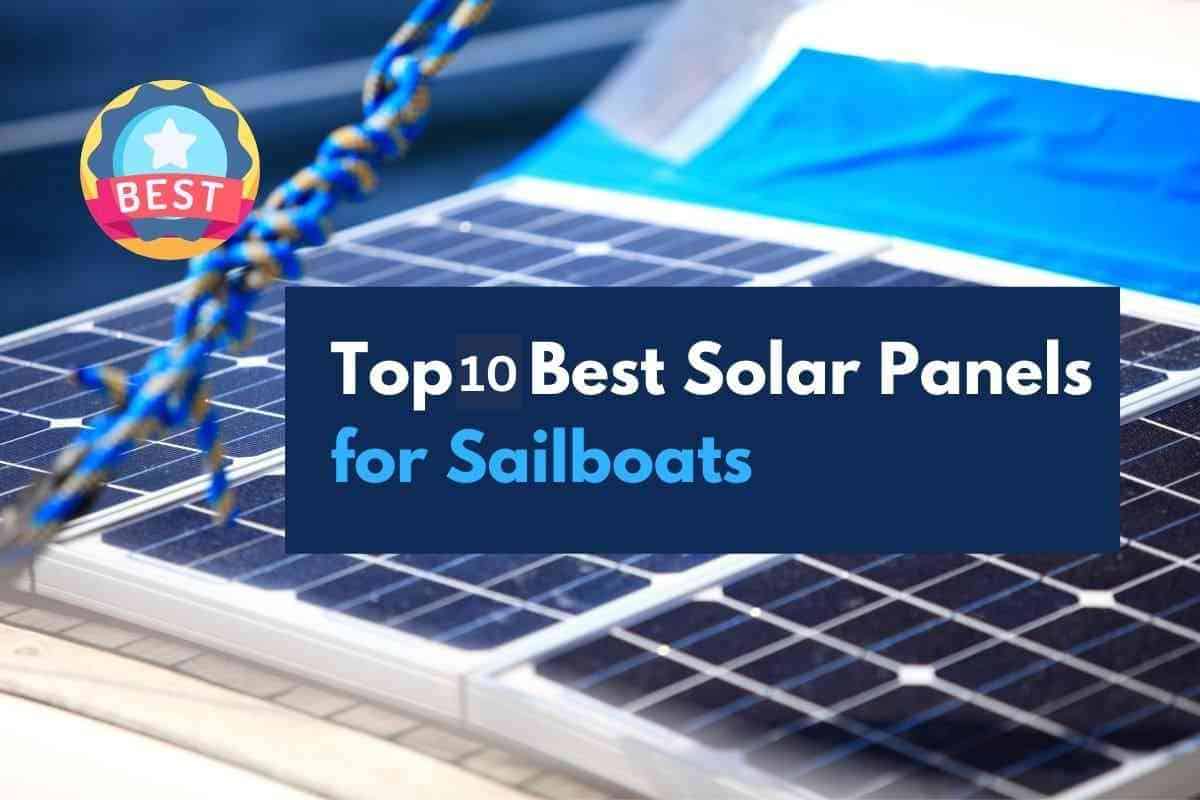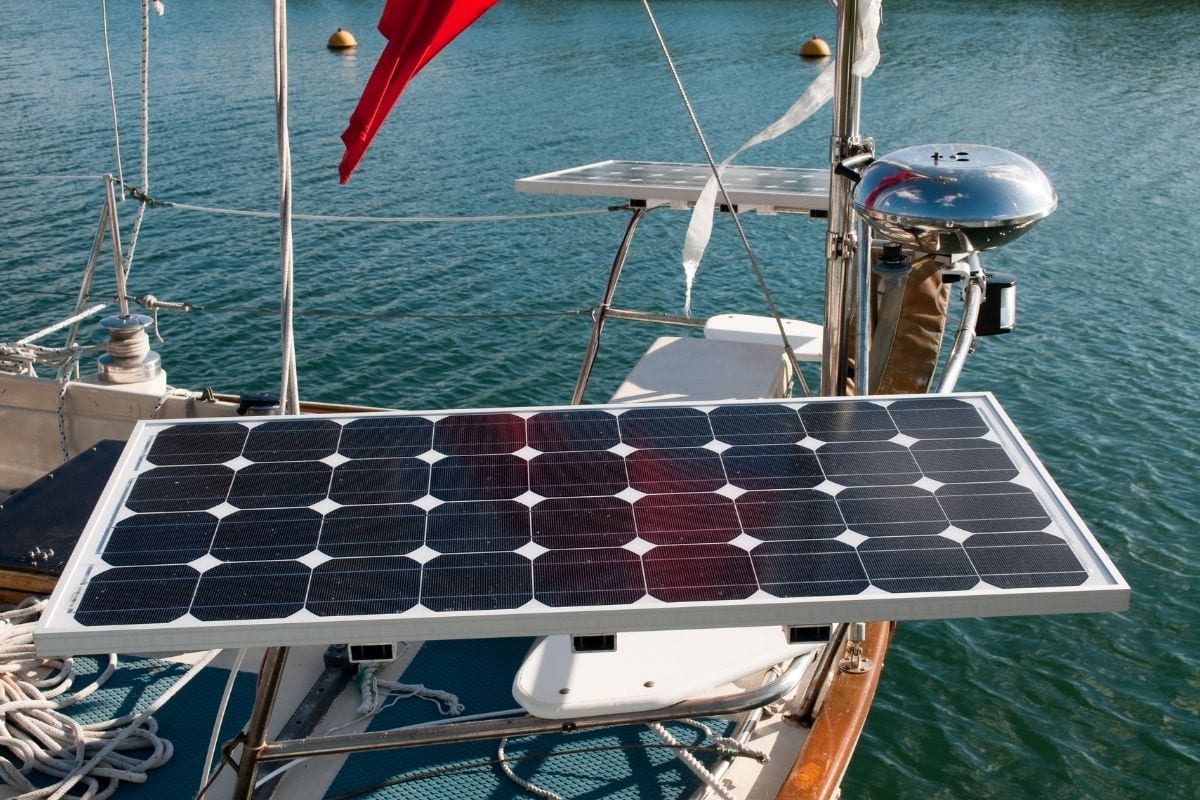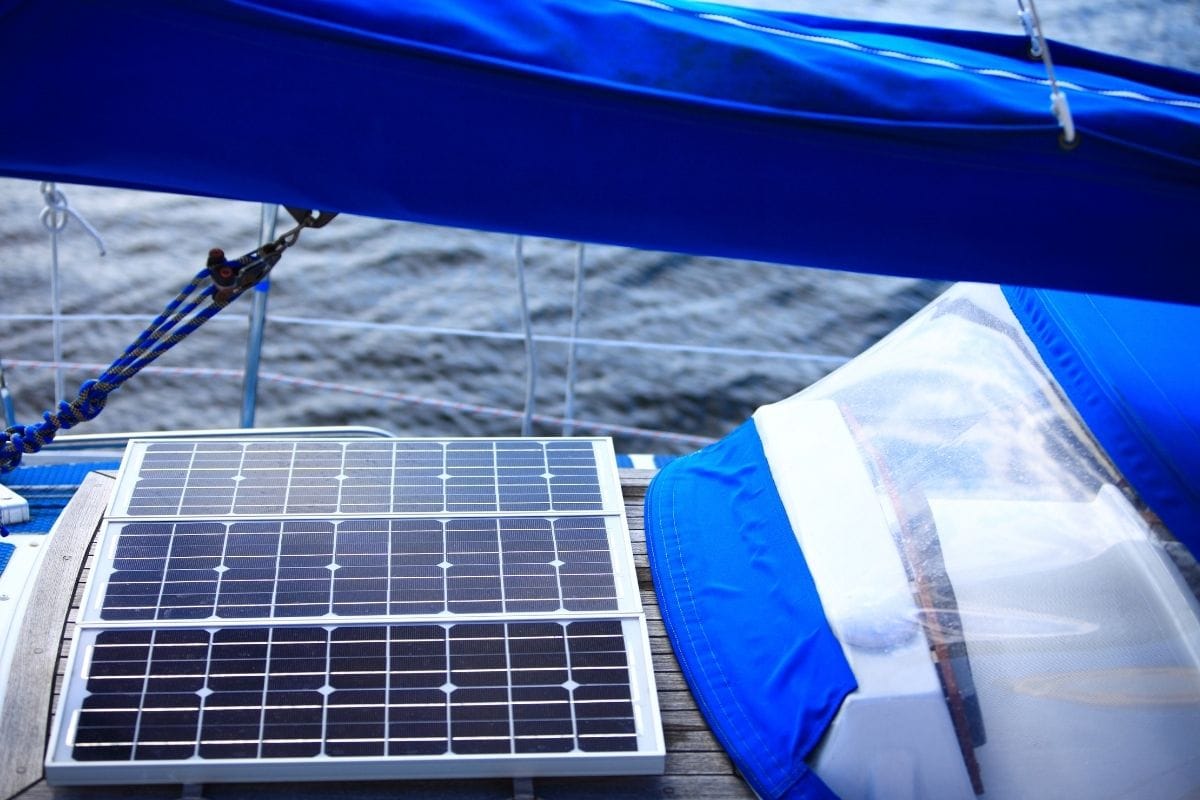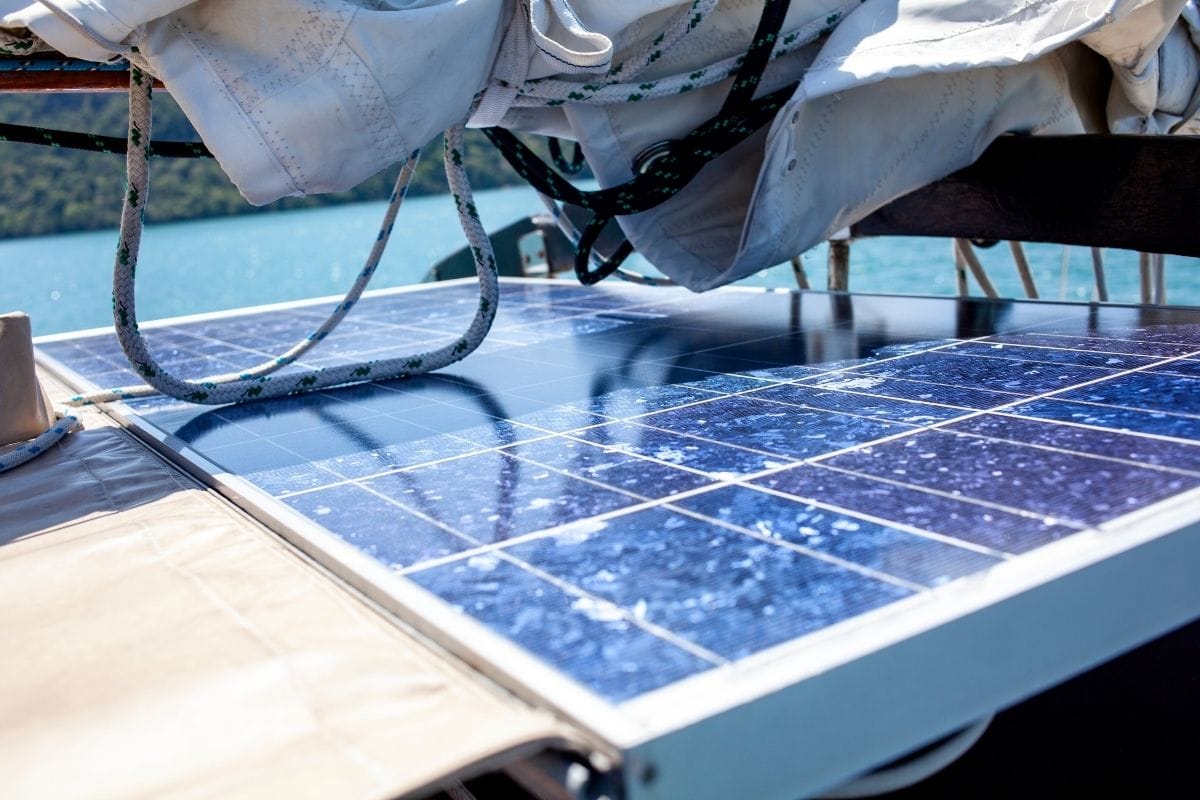Top 10 Best Solar Panels for Sailboats
The decision to install solar panels on your sailboat is a choice you shouldn’t take lightly. For starters, solar panels aren’t cheap—however, they can begin to pay for themselves quite quickly.
We’ll explain why you may want to use solar panels and all of the associated benefits.

Furthermore, you’ll find that there is a comprehensive guide that will inform you on which are the best solar panels for you and your budget. Keep reading to gain the knowledge and the confidence to install solar panels on your sailboat.
Benefits of Solar Panels for Sailboats
The benefits of having solar panels on your sailboat can prove to be invaluable.
They can be an absolute lifesaver if you are ever at sea for an extended period. Solar panels can be used to power amenities and objects of comfort, but they can also save your life in a life or death situation. Below are some benefits that may convince you to install solar panels on your sailboat.
Saves Money
Solar panels are expensive; it is much cheaper to charge your batteries from the marina or run a generator the entire time; this is especially true in the short term.
However, the alternatives to solar panels can become expensive over time. On the other hand, solar panels are a considerable investment initially, and then they pay themselves in the long run.
The solar panel eliminates the need to pay for power. Solar panels can last up to 40 years before the energy output becomes too inefficient.
Although solar panels might be pricey, there’s no recurring cost involved. You won’t have to worry about monthly bills, dock electric, or lugging around fuel. All you’ll need is access to natural light.

The upfront costs of buying a few solar panels pale in comparison to the countless fees you’d be forced to pay the marina or the amount of money spent on gasoline for your generator. In the long run, solar panels are a genius investment.
Emergency Power Supply
There’s always the possibility that you could be out at sea, and the winds begin to die down or even become too powerful, and you find yourself in a sticky situation. Perhaps you’re aimlessly floating at sea, waiting for favorable conditions to reappear.
Moreover, if you’re out at sea for a long time, your electronics could die. Whether it’s your radio, secondary engine, or satellite, your electronics are bound to fail given enough time. In these situations, having solar panels can literally save your life.
Comfortable Amenities
You could be sailing for a week or even just the day, but regardless of the time spent at sea, having access to enjoyable amenities can take the trip to another level.
In all likelihood, it won’t be possible to have such amenities onboard without a constant source of power at sea. For instance, having access to a tv, radio, kettle, video game console, or microwave oven may give the trip the level of comfort needed to run smoothly.
Although sailing can be exhilarating at times, there are those down times where you’re just bobbing around, and these are the times where you’ll need something to keep yourself entertained. Solar panels allow you to bring the comforts of land with you out to sea.
Eco-friendly
The alternatives to solar panels are taking power from the grid or a gasoline generator. Unfortunately, neither of these alternatives is good for the environment. Solar panels have the added advantage of being completely eco-friendly.

Having solar panels is not only easy on the environment, but it frees your senses from having to endure the constant running of a gasoline generator and all the unwanted gasoline smells that come with it.
Easy To Move
Perhaps one of the most convenient things about solar panels is that they’re easy to move. You can mount almost any panel if you have a good spot. However, when you’re in an environment where you’re constantly moving, such as a boat, you’ll need solar options that can move with you.
Corrosion Resistant
Most solar panels are made from corrosion-resistant aluminum and multi-layered cells. These two factors help your panel stand up to harsh conditions, including wind, rain, snow, and salty air, for years to come.
Charge Controller
A solar charge controller is a device that’ll keep your battery from getting overloaded by your solar panels. You don’t need to buy one, but it’s a good idea to invest in one when you get your panels. Using a charge controller can help extend the life of your battery and keep your boat from using too much power.
Space
Another thing to consider is how much space you have to install your panels. Solar panels come in all sizes, but you need to make sure you can put them in a spot that gets full sun. Sailboats often have limited deck space, so take note of measurements before buying your panels.
What’s In the Box
Some solar panels come with everything you need to put them to work right away. Others come with just a panel. For beginners, a starter kit will be the best choice. If you’re an experienced solar-user, you might prefer having to purchase all of your equipment separately.
Best Solar Panels for Sailboats
Now that you’ve learned of the benefits of solar panels installed on your sailboat, it’s time to choose which solar panels are best for you.
We’ve taken the liberty of compiling some of the best solar panels on the market. We’ve taken both budget and performance into consideration!
Renogy 400W Solar Kit
The Renogy 400W Solar Kit is perfect for those that plan to use their solar panels as the primary source of energy on the sailboat. You get four 100 W panels that can provide you with as much as 2000 watt hours a day. These panels can charge a 200Ah marine battery at least half way full within three hours.
This kit also has a 30A charge controller which improves the system performance and increases the battery life. It has an easy to use interface and LED indicators for the battery information and charge status. You will also receive an 8-foot cable to use for the battery.
The Renogy Solar Kit is the best option if you have a larger boat and the space to install the panels, because it gives you an option to use the engine for electricity or to utilize only solar energy in emergencies.
Be sure to have multiple batteries stored for days when it’s cloudy if you’ll be out at sea for a while.
The monocrystalline cells are highly efficient (21 percent) in comparison to polycrystalline panels which are more affordable but won’t give you as much power output. These panels can charge a 12-volt battery, there are 30 amps of current for each panel, and the entire kit weighs under 200 lbs
Nature Power 165W Solar Panel
The Nature Power 165W solar panel consists of monocrystalline silicon. This solar panel can comfortably allow you to maintain your boat’s batteries. Not only is this panel efficient, but this panel is very robust and durable. The solar panel has a very sturdy aluminum frame, and it uses a modular design.
This single panel can generate up to 165 Watts of power. What’s more, it will retain 80 percent of its efficiency after as much as 25 years—making it an excellent investment for years to come.
Furthermore, there’s even a 25-year warranty that the manufacturer gives you upon purchase. This solar panel is a great alternative to using a generator to power your boat, especially if you want something less noisy and a lot more eco-friendly.
This solar system comes with a modular panel that you can use to expand your system. It blocks the diode to prevent a reverse electricity current, and it’s very easy to install and comes with connectors that you can plug in easily. You can be confident on your purchase with a 25-year warranty, an 8-amp current, can charge a 12-volt battery, and only weighs 36 lbs.
WindyNation 100W Solar Panel
If space is a precious commodity aboard your boat, then the compact frame of the WindyNation panel will make installation easy for you, with top-level cell quality to boot. The polycrystalline construction allows the panels to put out 100W of power.
They are also more affordable than some other options on the list. If you live in a sunny area, the panel can produce up to 350 watt hours of power a day.This kit comes with 40 ft of solar cable, mounting brackets, all connectors, a 30 amp LED charge controller with multiple settings, and an instruction guide.
The controller gives you power to adjust the panels to your liking. operation and charging. The panels can charge a 17.4-volt battery, has a 5.75-amp current, and weighs about 18 lbs.
Winnewsun Flexible 100W Solar Panel
If you have a dodger, a Bimini, or any vessel with uneven surfaces, the Winnewsun 100 W solar panel is perfect. It also works well with curved surfaces. Its flexibility makes for an easy installation. It has a soft frame that bends to a maximum of 30 degrees, and you can adjust it as needed when attaching it to your boat.
Also, power output is perfect for powering devices you have onboard such as a mini-fridge, batteries, and more. This monocrystalline panel offers 25 percent cell efficiency, which is better than you get with most models. It only weighs four pounds.
This sailboat panel also comes at a budget-friendly price with easy installation instructions. It charges an 18-volt battery, has 5.6 amps current, weighs just 4 lbs, and comes with a one year warranty. These panels are cold, rain, and snow resistant.
AllPowers 60W Bendable Solar Panel
For those looking for a panel with a lower power output that still gets the job done, the AllPowers bendable solar panel is an excellent option. It delivers 60W of power and can withstand the elements better than most other aluminum panels. It comes with pre-drilled boats that make installation a breeze. The monocrystalline cells are 21 percent efficient.
You won’t have to worry about dust or water either, nor snow or gusts of wind or harsh conditions. It can bend 30 degrees and only weighs a little over two pounds for easy transportation and mounting on multiple surfaces.
This solar system charges an 18-volt battery, it comes with an 18-month warranty, and it weighs 4.5 lbs. It has a 3.3-amp current and works well to power small devices. If you have a larger boat these panels won’t be very effective unless you just want it to supplement your established electric system.
Renogy 100 Watt Monocrystalline Solar Starter Kit
Dimensions: 42 x 20 x 1.38 inches
Weight: 14.3 pounds (panel)
Voltage: 12 watts
The Renogy 100 Watt Monocrystalline Solar Starter Kit is a good choice if you’re looking for an all-in-one package for your boat. In addition to the rigid solar panel, you get a charge controller, adaptor kit, a tray cable, and a set of Z-brackets.
This panel provides up to 400 watt-hours (Wh) per day with 21% solar efficiency. However, you’ll need to make sure it has direct access to sunlight for at least 4 hours to get that. It’s ideal for smaller applications, which makes it perfect for use on a sailboat. The charge controller is Bluetooth enabled, but you’ll need to buy the adapter separately.
The panel is made of corrosion-resistant metal that can withstand high winds. So if you plan to take your boat out into the salty air, you won’t have to worry about damage. It’s also pretty easy to mount because it has pre-drilled mounting holes. An added advantage is that there are a lot of mounting holes, giving you ample flexibility.
Newpowa 210 Watt Solar Panel
Dimensions: 64.57 x 26.57 x 1.38
Weight: 24.41 lbs
Voltage: 12 volts
The Newpowa 210 Watt Solar Panel is the largest panel on the list, making it better suited for larger sailboats and heavier loads. Although this doesn’t come with mounting equipment, you’ll get diodes pre-installed with two 3-foot MC4 cables.
You could get up to 200 watts of power on a good day. Overcast days might be tricky, but of all the panels listed here, the Newpowa is excellent at handling dimmer circumstances. In addition, the updated monocrystalline cell design has a higher efficiency rating and conversion rate than older models.
The Newpowa is made of corrosion-resistant aluminum with multi-layered laminations to get the biggest boost out of your cells. Not only does this let them withstand rough conditions, but they’re great on cloudy days or in semi-shady areas. The pre-installed diodes also help keep your panel efficient in low light.
Topsolar 100 Watt Monocrystalline Solar Panel Starter Kit
Dimensions: 45.6 x 20 x 1.37 inches
Weight: 15.84 lbs
Voltage: 12
Topsolar’s 100 Watt panel is another excellent choice if you only want to place a single panel and get everything you need. This starter kit comes with a panel, 20A charge controller, Z-brackets, and solar cables. In addition, the holes are pre-drilled, so you’ll be able to get your panel up and running quickly.
This panel is made of tempered glass and a corrosion-resistant frame, which makes it perfect for extended use. In addition, it can handle high wind and snow loads. So, if you get stuck on the water on a windy day, you won’t have to worry about stowing your panel to keep it from getting damaged.
The included charge controller means your solar panel won’t overcharge your batteries. It’ll also protect against over-voltage and short-circuiting. The monocrystalline cells are excellent and produce high-efficiency power. It also has the benefit of USB ports, so if you have any USB chargers or items, you’ll be able to run them without extra equipment.
HQST 100 Watt Monocrystalline Panel
Dimensions: 32.5 x 26.4 x 1.18
Weight: 13.2 pounds
Voltage: 12
The HQST 100 Watt solar panel is great if you’re looking for solar panels that are easy to install. The package comes with the panel, junction box, and MC4 connectors with pre-drilled holes. You’ll have to buy the mounting brackets separately.
You’ll have 100 watts of power with this panel at a 21% efficiency rate. In addition, the bypass diodes help prevent power drops when you’re in the shade, giving you optimum performance even if the sun isn’t directly on it.
The HQST is also really well-made. The aluminum frame and multiple lamination layers can hold up against heavy winds, snow, and saltwater. The junction box is fully waterproof against splashes and low-pressure jets. You won’t have to worry about water damage from general use, but take care not to blast it with a hose when you’re cleaning up.
Renogy 175 Watt Flexible Solar Panel
Dimensions: 59.2 x 26.5 x .08
Weight: 6.2 lbs
Voltage: 12
The Renogy 175 Watt Flexible solar panel is one of the most versatile panels on the list. This completely waterproof unit comes with the necessary MC4 cables and connectors and pre-drilled mounting grommets that make it easy to hang up on hooks.
Made of lightweight polymer, this panel can flex up to 248 degrees, significantly increasing your mounting options. Its thin, flexible shape makes it a great choice on uneven surfaces. At 175 watts, it’s a bit underpowered compared to other options. Still, this is a convenient option if you have a smaller watercraft or don’t need to power much.
The monocrystalline cells are approved for marine use and can hold up to high wind and snow loads. The main thing you might have to look out for is corrosion. However, since they’re so easy to stash away, you can easily store them while you’re not using them to help prevent damage.
How to Choose the Best Solar Panels for Sailboats
There are multiple considerations when you’re buying a solar panel for your boat outside of the price tag. When shopping around for the best solar panels for sailboats, keep these components in mind.
Energy Requirement
When you buy a solar panel, the main factor that you want to consider is how much energy you’ll need while you’re out on the water. If you’re going to have a lot of devices that you need to power, it’s better not to try to cut corners by purchasing a small solar panel.

To determine how much power you need from your solar panels, you’ll have to calculate your power usage. So, take a look at what’ll need power on your boat and how much it uses. You can do this by checking the labels on your devices and reading what wattage is listed.
Contrastly, if you don’t need much power, there’s no reason to buy a large solar panel. For this reason, we provided a range of solar panels from as powerful as 400W to as low as 50W for power outputs to suit various needs.
Engine or Solar?
If you’re only going to be relying on nature, i.e., sunlight, for power, then you have to buy solar panels large enough to convert the sunlight you accumulate into electrical energy. If you use the engine to power your boat, you have the alternator for electricity, and you don’t need such a big or powerful solar panel.
If you go on short trips, think of it this way. Having access to more solar energy means you’re not reliant on the engine for electricity. In the instance that something contaminates your fuel or your engine dies, you can count on solar power to keep the electrical system afloat on your vessel.
Amp Draw
Think about the devices that you’re going to use the solar panels to power. You can buy the perfect panels based on the number of devices and calculating the amp draw.
Look at the product information for the item that you want to power to see the daily amp requirement. Once you check this info for all of your devices, you’ll see how many amps you’ll need each day, and that can be the deciding factor for which solar panel you pick.
You could also calculate your needs based on a device that calculates amps. It informs you of how many amps are flowing from your batteries in a set period. If you read this information for a few days, you’ll get an idea of the average number of amps you use per day.
Situate your solar panels so that you have enough to cover your needs. It’s always better to go a little higher than what you actually need, just in case. Also, don’t forget to plan for cloudy days.
Maximum Output vs. Actual Output
When you check the solar panel power rating, consider the maximum output specified. It requires that you have a perfectly sunny day to get that max power.
Do you reside in a city that is usually sunny all year round, such as California or Florida? If not, you won’t be able to achieve that power output very often. So, plan accordingly when you make a purchase.
During the winter, the sun isn’t as powerful as it is in the summer. When it’s foggy and cloudy out, your solar panels will put forth less power. Keep all of these details in mind when you’re considering your setup.
Boat Size
How big your solar panels are will initially depend on how big or small your boat is and where you’ll install them. Typically, the larger the boat, the larger the solar panel you’ll need to power it. Always check the panels’ efficiency, as the size can be misleading at times. A big panel doesn’t necessarily equal an efficient panel.
That means it also won’t give you the power output you want. Always try to get the panel that gives you the most power with the smallest carbon footprint.
Material
A majority of solar panels have silicon construction. Depending on the production, they could be polycrystalline or monocrystalline. You get a higher power output and more efficiency with monocrystalline panels, but they’re also more expensive.
Polycrystalline panels don’t give as much power, but they’re much more affordable and perfect for those on a tight budget. Never compromise what you actually need for the price, as you usually end up paying for it later.
Final Thoughts
It can be incredibly boring out to sea without adequate power; luckily, we have solar panels to harness the power of the sun. It’s always best to use natural energy whenever possible, as it’s better for the environment, and the sun doesn’t run out.
They will pay for themselves over time, and it ensures that you always have a backup source of power in an emergency situation. If you have the means and the space to invest in a high-quality solar panel, don’t hesitate to do so!









